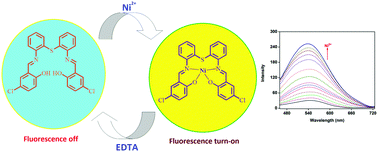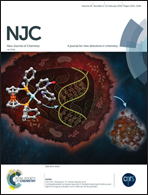A Schiff base receptor as a fluorescence turn-on sensor for Ni2+ ions in living cells and logic gate application†
Abstract
A new receptor (R) with easily available “off–on–off” colorimetric and fluorescent responses was synthesized and characterized using 1H NMR, 13C NMR, and ESI-MS studies. It exhibited selective and sensitive detection towards Ni2+ ion without having any interference from other tested metal ions. The changes in the obtained photophysical properties are due to the chelation-enhanced fluorescence effect (CHEF) caused by the ligand-to-metal charge transfer (LMCT) that occur after the addition of Ni2+ to the receptor. Density functional theory (DFT) calculations have theoretically supported the changes in the examined absorption and fluorescence spectra. Moreover, the receptor could be successfully oriented with the molecular logic functions of OR, AND, NOR, and NOT gates. Furthermore, the receptor efficacy was studied by examining the changes in intracellular Ni2+ in the HeLa cells. The receptor has been explored for a possible application in the real sample analysis and a test kit for the detection of Ni2+.



 Please wait while we load your content...
Please wait while we load your content...